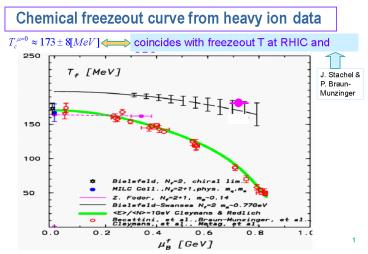Chemical freezeout curve from heavy ion data
1 / 22
Title:
Chemical freezeout curve from heavy ion data
Description:
From LGT to HRG Phenomenology: quantitative analysis. of T-dependence of thermodynamics ... YES: Phenomenological partition function of. Hadron Resonance Gas ... –
Number of Views:60
Avg rating:3.0/5.0
Title: Chemical freezeout curve from heavy ion data
1
Chemical freezeout curve from heavy ion data
coincides with freezeout T at RHIC and SPC
J. Stachel P. Braun- Munzinger
2
Critical and Freezeout Conditions
in Heavy Ion
Collisions Krzysztof Redlich
QCD Thermodynamics of confined phase
?
- Heavy Ion
- Phenomenology
- through
Lattice Gauge Theory at finite and
Based on common work with Bielefeld-Swansea LGT
Coll. C.R. Allton, M. Doring, S. Ejiri,
S.J. Hands, O. Kaczmarek, F. Karsch, E.
Laermann, K.R. Shinji Ejiri, Frithjof Karsch
Thermodynamic pressure Charges
Fluctuation Chiral Condensate Quark mass
dependence of QCD thermodynamics below
deconfinement critical chemical freezout
conditions
3
Taylor expansion of resonance pressure
Factorization of the net baryonic pressure
baryon mass spectrum
Compare with LGT results
Consequences
For fixed any ratio of
these observables is T-independent
the ratio of the O(2), O(4) and O(6)
coefficients
4
factorization on the Lattice
HRG
HRG
ratios consistent with
the expansion of cosh(x) expected in HRG
partition function
Ratios of all baryonic observables independent of
temperature for fixed
5
quark condensate at finite density
Baryon contribution
Net baryon pressure
In 2-flavour LGT calculations
6
Isovector and electric charge fluctuations
0 for
related with space-like screening limit of the
retarded photon self-energy
In LGT obtained from
,however requires
independent Monte-Carlo calculations
7
Isovector susceptibility in LGT and
resonances gas
on the lattice
expanding cosh(x) one expects
LGT result supports decomposition of meson baryon
contribution in confined phase
8
From LGT to HRG Phenomenology quantitative
analysis of T-dependence of thermodynamics
In HRG the pressure can be appr. obtained
from the Taylor coefficients of
LGT results from Integral method
use cs from LGT check P?
provides good
T-dependence of LGT pressure
9
To check T-dependence of the EQS requires
LGT results for pion mass dependence of and
their parity partners
2
QCDSF Coll., M. Göckeler, et al..
10
Hadron resonance gas model and LGT
susceptibilities
At only 10 is due
to pions contribution
Including interactions e.g. actually reduces
fluctuations (R. Rapp J. Wambach)
11
Isospin multiplets contribution to QCD
thermodynamics
Diferent Isospin states contribution to the
thermodynamic pressure
Connected with LGT coefficient in the Taylor
expansion of susceptibilities
12
Quark mass dependence of QCD thermodynamics
below deconfinement
Linear dependence of on the quark
mass in LGT
13
Deconfinement is density driven -
(percolation)
Hadron resonance gas partition function
LGT result shows dependence
of on and , however for
and for all
provides a good description of m and Nf
depen. Of deconfinement
temperature
A. Peikert, et al..
condition for deconfinement
hadrons
hadrons
glubols
H. Satz
percolation deconfinement
lines of constant energy density in HG
14
Phase boundary of fixed energy density
versus chemical
freezeout
Spliting of chemical freezeout and phase
boundary surface most likely appearswhen the
densities of mesons and baryons are comparable
For Elt30 AGeV strong collective effects in
hadronic medium are to be expected
LGT
SPS 40 AGeV
J. Cleymans et al..
Mesons
Baryons
15
QCD Thermodynamics
- Heavy Ion
- Phenomenology
Lattice Gauge Theory
?
YES Phenomenological partition function of
Hadron Resonance Gas
provides satisfactory description of LGT
thermodynamics at finite ,
and
16
Taylor coefficients of isovetor susceptibility
from LGT and resonance
gas model
As expected in resonance gas model
LGT results support decomposition expected in
HRG-model
17
Hadron resonance gas model and LGT
thermodynamics
18
factorization on the Lattice
19
QCD at non-vanishing chemical potential
Bielefeld-Swansea
approach
Up to O(6) order in
complex fermion determinant
Taylor expansion of
,
From dependence of chiral
susceptibilities
20
Hadron Mass Spectrum versus quark mass
chiral limit
quenched limit
from LGT or Bag Model
21
Bag Model and Hadron Masses
- --------------------
- --------------------
- ---------------------
- ------- ---
- ----------------------
- ----------B-----------
surface boundary -
conditions
- Hadron Masses from
- for and
q
g
q
q
g
22
Isovector susceptibility in LGT and
resonances gas
on the lattice
expanding cosh(x) one expects
thus































